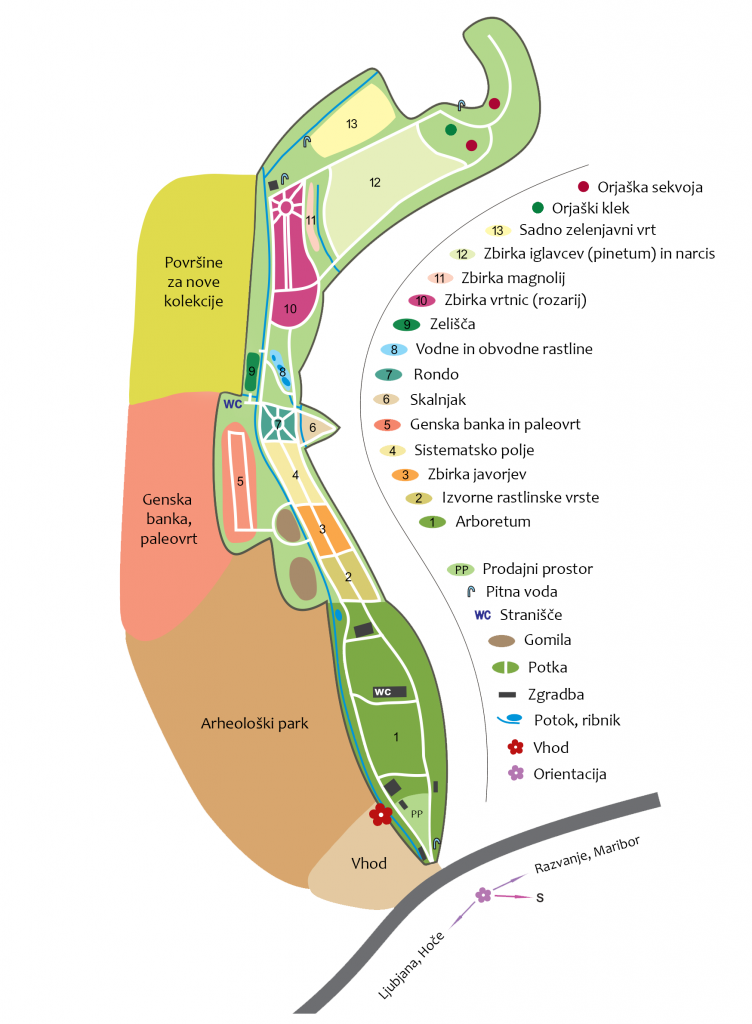Map of the garden

1. Arboretum with ornamental shrub collections
The largest area of nearly 20ha of the garden area is an Arboretum, covered with woodland, providing place for many ornamental shrub collections, such as Rhododendrons, Hydrangeas, Viburnums, Euonymus and a small collection of carnivorous plants. Rhododendrons are very popular ornamental shrubs. They start flowering towards the end of April and usually flower throughout May. This site is an ideal area for Rhododendrons, with long morning shade, sheltered from strong winds and provided with enough ground moisture. The enterance area also covers two multipurpose buildings with areas for exhibitions and events. In the multipurpose buildings visitors can find toilets and vending machines. This area is situated close to the enterance where visitors can buy produce and products of our agricultural estate – fresh fruit, vegetables, apple juice, wines, vinegar and many other.
4. The systematic area
Collections of plat families are showing the evolution process from the most simple plant species (Aristolochiaceae, Ranunculaceae) to more complex species botanically (grasses, monocots, orchids). There are over eighty plant families in over fifty beds, with the collection of genus Cornus at the bottom side.Collection is a teaching tool for botany studies at all levels.
5.The field gene bank
The collection is representing some of the most popular apple and pear cultivars, which were used in slovenian orchards before many modern cultivars were established. There is also an area planted with many specimen plum and cherry trees, serving as a field gene bank. Raspberry, elderberry and pumpkin cultivars are also planted, mostly for research purposes. Since 2018 there is also a collecton of over 100 old wheat cultivars starting from the ancient varieties.
8. Water and bog plants
The collection covers many plant genera, that thrive in wet, boggy areas or near water. Many protected plant species growing here are slovene native. This area is also a teaching tool for learning plant and animal interactions, habitat protection, sustainability,… Nearby are beds of Iris and Hemerocallis collections.
10. The Rosarium
The Rosarium is borderlined with low box hedge. Tea and shrub roses are planted in beds, two main parts of rosarium are connected with metal arches, giving room for rambler and climbing roses. Top of rosarium spreads out like rays and is planted with roses in company of perennials. Flowering starts in spring and lasts till first frosts. Looking best in June! Rosarium was replanted in 2014, now holding nearly 100 cultivars, most of them new and pest and disease resistant.
12. The Conifers and Narcissus collection
The Pinetum, the collection of conifers, was the first area of botanic garden to be planted in 1996. Location was chosen because of an existing collection of north american tree species, which dates back in late 1800. Still magnificent today, the focal point of the pinetum, are ‘the giants’: Sequoiadendron giganteum and Thuja gigantea, both over 40m high and over 120 years old. To brighten up the greenery, collection of Narcissus was planted in 2010. It now covers well over 100 different cultivars.
13. The fruit and vegetable garden
This part of the garden resembles family vegetable garden with rows of various soft fruit varieties. Some less ordinary edible shrubs and ideas for pergolas are presented. Here visitors can find sitting area in the shade of elm and hazel trees.
Besides the soft fruit varieties there is also a small orchard with common fruit varieties grown in Slovenia, such as apples, pears, plums, cherries, peaches and kaki (persimom).
